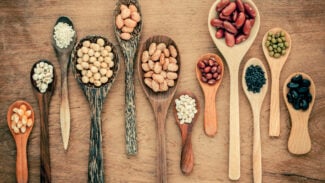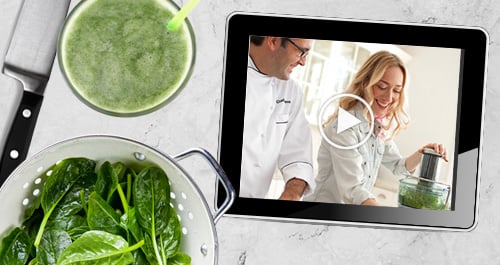Hi Beautiful,
Does this charming chant ring a bell? Beans, beans, the magical fruit. The more you eat, the more you… toot! Whether this tune gives you the giggles or makes you blush, you get the point: beans wake up your gut!
Beans are an essential component to any plant-based diet. They’re loaded with protein and fiber and add heft and heartiness to any meal. Did you know that there are more than 800 varieties of beans? Holy abundance!
What you may not realize is that the more you eat beans, the better you feel. And there are many things you can do to make friends with this fibrous food if you find that they cause some digestive discomfort. (Get loads of tips here!) Since I’m such a huge fan of these thrifty, nourishing and tasty members of the plant family, I feel a little education on this pantry staple is in order. And I turned to my handy-dandy cookbook, Crazy Sexy Kitchen for some assistance…
Let’s start with the basics. How do you choose the best beans?
Dried or canned? I buy dried beans in bulk (saves money!) and store them in mason jars. But it’s always good to have a few cans around for those times when you haven’t soaked your beans and are in a rush. When buying canned beans look for BPA-free products without preservatives, such as calcium disodium EDTA. Also, try to use low-sodium varieties and make sure to rinse them well (no need to pickle yourself!). Bonus tip: Brands like Eden add kombu (seaweed) to their canned beans, which make these tasty dudes easier to digest.
How to prep for ultimate pep!
First, let’s learn about enzyme inhibitors and phytic acid. Beans, seeds, and legumes contain enzyme inhibitors, which delay germination (when a plant emerges from its seed and sings, “Hello, world!”). In nature, rain triggers germination. If we eat these foods before soaking, then it hasn’t “rained” yet and the enzyme inhibitors and phytic acid are still intact. Who cares? Your belly!
Enzyme inhibitors block and bind with our digestive and metabolic enzymes. What are they? Digestive enzymes help to break down our food, while metabolic enzymes support every amazing function in our bodies. Bottom line, we don’t want to mess with them. Soaking beans triggers germination which neutralizes enzyme inhibitors.
Phytic acid in the body decreases our ability to absorb key minerals, such as calcium, iron, magnesium, and zinc. These minerals are crucial for peppy health. Soaking our beans until they germinate activates the chemical phytase, which is an enzyme that neutralizes phytic acid. Voilà!
How to cook your beans
Step 1: Draw Your Beans A Bath
Place them into a bowl filled with water. Swish the little suckers around, strain, and repeat until the water is clear. This helps to remove dusty residue and the occasional dead bug (ew!), not to mention stones. Yup, from time to time you might find a little rock in your batch. Protect your choppers with a quick sift.
Step 2: Soak, Soak, Soak!
As we just mentioned, soaking your beans overnight will greatly reduce enzyme inhibitors and phytic acid, making them easier to digest (less toots!). Just be sure to use fresh water for cooking. Even if you can only soak them for a few hours, it helps and your body will thank you. And get this: soaking beans for around 18 hours can reduce phytic acid by 50 to 70 percent. Dang! Plus, soaking your beans first will reduce cooking time.
Bean Bonus: Adding a piece of kombu (seaweed) increases the effectiveness of this process.
Step 3: Boil, Baby!
Just about all dry beans have a similar cooking method. Start with cold water and beans in a large pot. Bring to a boil and then turn down to a simmer. Cover the pot, leaving the lid tilted just enough to allow some steam to escape. Beans are done when they are tender and the skin is still intact.
Tip time: What’s Up With Salt?
Salt pulls moisture from beans, so wait until they’re almost tender then add salt to the cooking water. You’ll avoid adding too much sodium, which would just get lost during the cooking process.
Your Ultimate Bean Chart
Get your bean facts at a glance, plus cooking tips with your fun and fabulous Crazy Sexy Guide to Beans!













Great job!
I grew up eating beans as a complement with many other foods Thanks to you now I know that sink them is better. Sometimes when you cook them they can dry, you can add extra water when they are cooking but is better to add boiling water, 🙂
Greetings from sinaloa mexico
What about jelly beans???!
Thanks for the chart! 🙂
Something to think about when looking for BPA Free products. http://www.edf.org/health/four-reasons-bpa-free-wont-protect-you?s_src=ggad&s_subsrc=bpa&gclid=CPr0o6bzxb4CFQVsfgodoUgAAA
Instead of soaking beans overnight, after washing I put them put them in pot with water, bring to a boil, and turn off — letting them sit for about 10 min. I then rinse beans thoroughly with cool water. I fill with water again and repeat this process at least 3 times. I know it seems like a lot of work, but it will definitely almost get rid of all the bloating that comes along eating beans. After the last rinse, proceed to season and cook your beans according to your recipe.
My favorite way to cook beans is in the crock pot, mostly because it’s so easy. Soak beans overnight, throw in crock pot in the morning, check in a few hours. They are really flavorful this way, too, especially if you add any flavor to the beans as they cook.
Hello Kris Carr,
GREAT chart. I “shared” it with my Facebook “friends” (>2k).
Just two things I would add when you talk about beans:
1) add LENTILS to your bean cooking chart
2) please note that the BEST way to reduce gas after eating beans (of course they’ve
got to be well soaked and cooked)…..is to AVOID ANYTHING SWEET, even fresh fruit, after
eating beans.
Please KEEP UP YOUR EXCELLENT SERVICE TO OUR Dear World!
Mary Farkas
Bean cream!! You cook black or pinto beans, caramelize some onions and add beans and coconut milk, salt, and herbs (I like epazote or oregano), and off to the blender! You have the cream with croutons, thin tortilla chips, or cheese squares… Yumm!
This is such a great resource! And the title made me giggle 🙂
Nice chart. Would be nice to see a similar chart for slow cooker use too. It seems that red kidney beans are the most important to cook right.
I’ve tried so many times to re-create the “Tasty Bites – Madras Lentils” and not a single recipe online seems to have the exact ingredients listed on the box and they usually add or take from it. I think a combination chart for slow cookers would be great as well since cooking times are so much different, as you can’t leave lentils in the slow cooker the whole time you’re cooking kidney beans or they’ll turn to mush. i prefer to make from scratch without a recipe, but I can’t afford to waste a whole batch if the beans end up improperly cooked or overcooked.
Thank you for this great article! I am so tired of the latest fad diets that are trying to say beans are bad for you (paleo). This was a great summary of the essential info we need for understanding any concerns people may have about the benefits of eating beans. Keep up the greatbwork!
My fav is roasted chickpeas! They get nice and crunchy and can be spiced a million different ways- a really great tasting and satisfying snack!
Beans are seeds, not fruits… ty
Should I worry about getting organic beans? I know many beans are sprayed with pesticides, however with the soaking, and the boiling process of cooking beans is it necessary to worry about that?
Does Cha-cha-cha-CHILI freeze well?
Thanks
Can you give me some scientific information about Lectins. They seem to be in everything considered healthy in a plant based diet, especially in beans and night shade vegetables. Thanks.
An outstanding share! I’ve just forwarded this onto a coworker who
has been doing a little homework on this. And he in fact bought me breakfast simply because I discovered it for him…
lol. So let me reword this…. Thanks for the meal!! But yeah, thanx
for spending time to talk about this topic here on your web page.
Once soaked or cooked, how long do they keep? I’m envisaging soaking / boiling batches at the weekend so I can use then quickly for meals throughout the week. Would they last a week in the fridge? Would you store them in water or as they are?
Thanks!
Hi there, Rebecca! This is Jennifer with Team Crazy Sexy. Personally, I find that storing the cooked beans in the fridge (not in water) last about a week. I’d worry that storing them in water would break them down too much. You can freeze beans too (more on that here: How to Stock Your Freezer for Easy Vegan Meals). Happy cooking!